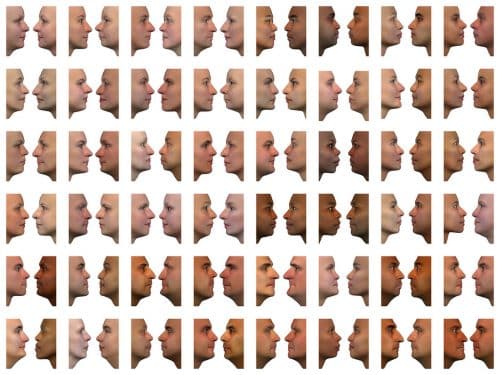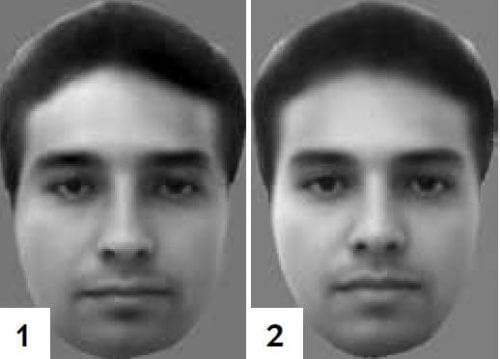Scientists have deciphered how we recognize faces and reconstructed what the brain sees from its electrical activity

The human brain has evolved to be able to recognize and remember many different faces. We are able to immediately recognize the facial features of a friend among dozens of people in a crowded restaurant or on a busy street. Also, a short glance is enough for us to determine whether the person is excited or angry, happy or sad.
Brain imaging studies have revealed that some areas, the size of a blueberry, in the temporal lobe, the area under the temples, specialize in reactions to faces. Scientists call these areas "facial areas", but both brain scans and clinical studies conducted on subjects with implanted electrodes have not been able to explain exactly how the cells in these areas work.
Now, thanks to a combination of brain imaging and recordings of single neurons in macaque monkeys, it appears that the biological Doris Tsau and her colleagues at the California Institute of Technology (Caltech) succeeded in cracking the neural code for facial recognition in primates. The researchers found that the firing rate of each cell in the face plots corresponded to a separate facial feature. These cells can be precisely tuned, like an array of dials, to respond to small bits of information, and then combine that information in different ways to create a picture of each face the animal encounters. "It was amazing," says Tsao. "The values of each dial are so predictable that we are able to reconstruct the face the monkey sees simply by recording the electrical activity in its face-recognition cells."
Previous studies have already provided clues as to the specificity of these brain regions in encoding faces. In the early XNUMXs, when Tsau was a postdoctoral fellow at Harvard Medical School, she and the electrophysiologist Weinrich Freiwald They showed that neurons in the facial regions of monkeys fired whenever the animal saw pictures of faces. The same cells showed little activity—or no response at all—to other objects, such as pictures of vegetables, radios, or body parts other than faces. Other experiments have suggested that the neurons in these areas can also distinguish between faces, even when the faces are drawn in outline.
In a famous set of experiments conducted in 2005 on human subjects, the neuroscientist discovered Rodrigo Kian Quiroga that images of the film actress Jennifer Aniston activated a single brain cell in the hippocampus region (which was subsequently named "Jennifer Aniston's nerve cell"). According to Kian Kiruga, who now works at the University of Leicester in England and was not involved in the current study, the hypothesis was that a similar process occurs in other places in the lateral lobe, and the popular explanation is that each nerve cell in the facial areas is sensitive to a small number of specific people. But according to Tsao's new research, it seems that this belief is wrong. "She showed that neurons in the facial areas do not encode specific people at all, only certain facial features," says Kian Kiruga. "It completely changes our understanding of how we recognize faces."
To decipher how neurons perform this recognition task, Tsao and postdoctoral fellow Stephen Le Chang produced 2,000 human facial photographs with changes in 50 facial features, including facial roundness, eye distance, and skin color and texture. They showed these images to two monkeys, while recording the electrical activity in single neurons in three separate areas of the face.

The researchers found that each neuron responded to only one letter. According to Chang, instead of encoding the individual faces, like Jennifer Aniston's neuron in the hippocampus, the neurons in the facial regions divided the images into smaller regions and encoded specific facial features, such as the width of the hairline. Also, the neurons in different facial areas processed additional information. Similar to workers in a factory, the different parts of the face have different roles, and they cooperate, communicate with each other and rely on each other to create the complete picture.
Once Chang and Tsao understood how this division of labor occurred, they were able to predict the neurons' responses to an entirely new face. They developed a mathematical model in which facial features are encoded by different neurons, and then showed the monkeys an image of a face that had not been shown before (1). Using the algorithm for predicting nerve cell responses, the researchers were able to digitally reproduce the faces the monkeys saw (2). "The reconstructions were incredibly accurate," says Tsau. In fact, it was very difficult to distinguish them from the images the monkeys actually saw.
According to Tessau, what was even more surprising was that the researchers had to rely on a relatively small number of neurons to accurately reproduce the faces the monkeys saw. The algorithm was satisfied with records from only 205 cells - 106 in one plot and 99 in another. "It really demonstrates how compact and efficient this character-based neural code is." This may also explain why primates are so good at facial recognition, and how we might recognize faces out of billions of different people without needing a similar number of face cells.
The research findings, Recently released In the journal Cell, scientists are provided with a comprehensive and systematic model of how the brain perceives faces. According to the researchers, this brain mechanism in humans is very similar to that of monkeys, and we too have facial areas that respond like theirs, as demonstrated by functional magnetic resonance imaging (fMRI) studies. However, the number of facial areas in humans may be different.
According to Adrian Nestor, a neuroscientist at the University of Toronto who studies facial smoothness in human subjects and who was not involved in the current study, understanding the brain's code for face recognition could help scientists examine how face cells use additional identifying information, such as gender, age, race, emotional cues and names. This understanding can even serve as a framework for understanding how the brain processes shapes that are not faces. Nestor explains that "in the end, this riddle is not only about faces. We hope that this neural code also encompasses object recognition in general."
for further reading

7 תגובות
It is most likely that the neural systems that recognize unique faces work to a similar extent or in a similar way in identifying and reacting to specific sites in space and in a similar way to identifying and reacting to significant social situations and stimuli.
It is most likely that similar systems operate in response to many other complex situations and stimuli, for example sounds or smells in many other animals.
The important interesting question is what is the degree and structure of the neural complexity that characterizes a richness of responses
Uniqueness within a large collection of many different situations.
For example, can the number of nerve cells be a limiting factor for the abilities for complex reactions?
I would be very happy to receive comments on the subject
.
The statement that a short glance is enough to identify a person's mood is not true. Humans are masters at hiding emotions, and in addition - studies have shown that our facial expressions are culturally dependent?
First link:
https://www.youtube.com/watch?v=uSUOdu_5MPc
After all the site upgrades, the most basic things still don't work as they should.
Why don't the links become clickable?
Trying again, first link:
https://www.youtube.com/watch?v=uSUOdu_5MPc
Second link:
https://www.youtube.com/watch?v=0qVOUD76JOg
It reminds me of something cool and relatively new that I came across in the past, a method that makes it possible to extract images of visual memories from a neural network. For now, this method has only been used for artificial networks, but I see no reason why it wouldn't also work with a human brain while electrodes are connected to it that model some kind of grandmother's cell inside.
Here is a first example (by the way, you can turn on subtitles in Hebrew) the segment itself starts at minute 11:10 and the really interesting part starts at 14:35 although you shouldn't skip the introduction:
https://www.youtube.com/watch?v=uSUOdu_5MPc
And here is another example when the interesting part starts at minute 09:20:
https://www.youtube.com/watch?v=0qVOUD76JOg
So can you actually take the brain's facial recognition algorithm and apply it to facial recognition software to optimize it?